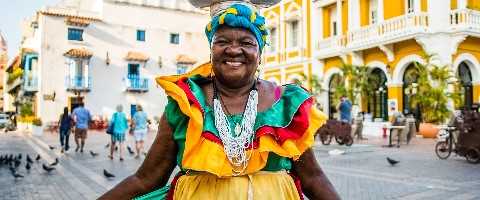If you happen to be reading this, then you are considering exploring South America's rising star. Seemingly almost a continent in its own right, Colombia has it all, packed into a landmass the size of France, Germany and the UK rolled into one.
Forget the drug lord reputation - a thing of the past. Here is an overwhelmingly friendly country with appeal to all age groups and all interests; a country that spells not only nature and adventure but culture and sophistication with a history to match.
So don’t stop at simply pondering as to whether you are bold enough to tackle Colombia when you can so easily experience it. Here you have a landscape of snow capped Andean mountain peaks reaching close to 6,000 metres into the sky, Amazonian rainforest, wild rivers and waterfalls, national parks, coffee plantations, hideaway islands and Caribbean beaches. But it does not all stop there because mixed in with the natural wonders are pre-Columbian sites, the three vibrant cities of Bogota, Medellin and Cali, colonial architecture galore and the UNESCO World Heritage town of Cartagena, the jewel in Colombia’s crown and one of the most beautiful cities in Latin America.
Set in the northwest corner of the continent, Colombia is bordered by Venezuela, Brazil, Ecuador and Peru. Here we have one of the world's 17 megadiverse countries, boasting 55,000 plant species (second only to Brazil), 1,885 bird species, 524 reptile and 754 amphibian species. For orchid lovers there are 3,500 species to discover. The dozen ecological zones consist of coastal mangrove forests, swampy wetlands, deserts and desert-dry deciduous forests, amongst others. But it’s the mix of natural beauty and its history that has made Colombia, still unknown to the traveller, the most exciting country to visit. The early 16th century saw a seemingly constant flow of Spanish conquistadors searching for the legendary El Dorado and, in their wake, they left 500 years of turmoil and bitter strife. Independence came in 1810, but there followed another 150 years of civil war. However, stability under two enlightened presidents has demonstrated the enormous potential that this country has on the world stage, and tourism is growing in leaps and bounds.
Having an equatorial climate, seasonal variations in temperature are slight. These are generally influenced by elevation, ranging from 32 degrees on the coast to 20 degrees or so in Bogotá, the capital, at nearly 3,000 metres. December to March is the country's summer season and is the dry season in the coastal resorts.
For both young and old there is adventure unlimited and our itineraries capture both the variety and natural beauty of the country and its fascinating urban culture.
At a glance
- Colombia has an equatorial climate therefore seasonal variations are minimal - it is more a question of elevation
- 440,000 square miles and 45 million population
- December to March is the high season in terms of tourism and the dry season in the coastal resorts
- Located in the northwest corner of South America
- Bogotá is the capital
- The national currency is the Colombian Peso
- Rich diversity in geography, wildlife and culture
- Its terrain ranges from Amazon rainforest to Andean peaks
- Safety in the country in most regions is now as good as any other South American country







